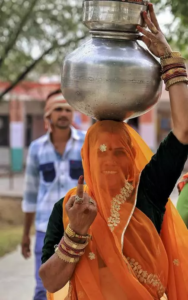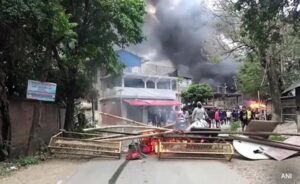It has been some time since the horrific incident in Uttar Pradesh’s Ambedkar Nagar where a 15-year-old girl died because two men passing by pulled her dupatta (stole), making her fall. A passing motorbike ran into her, killing her immediately. To be noted, it wasn’t that she was harassed and died that made the news – it was because those guys tried to snatch arms from the policemen nearby and tried to run, eventually getting shot in the legs by the police.
No woman in north India would have been stunned by the news. Angry, yes. Surprised, no. We have all grown up with several incidents like this – mostly being ‘lucky’ with just falling, scratching our knees, elbows, injuries to forehead, depending on how badly you fell and where you knocked yourself. When I read the news, there wasn’t one incident that cropped up, there were way too many and the anger didn’t subside.
There are well known reasons for patriarchy behind street harassment and violence, especially in north India. Lots of conversations on dress code for women – mostly why they shouldn’t wear western clothes. Yet, I have always found a severe lack of conversation on the imposition of salwar-kameez and dupatta (Indian long shirt, loose trousers and stole) imposed on young girls and women, as soon as they turn 12 or 13, and how utterly sexualised it is. Patriarchy starts from homes, not the streets; and the role of parents, especially mothers, cannot be ruled out. The way they impose ‘new clothes’ on their daughters, and never have a conversation with their sons about respecting women or even their own sisters.
I did my basic schooling in Karnal, Haryana because my parents taught at a college and school there. Even though Karnal is a town with a huge migrant population – 1947 and 1984 Punjabi refugees – the Jat culture still rules. Punjabis have a similar cultural background so in spite of land and resources- related animosity, they gel well together culturally.
Most of my classmates were Jats or Punjabis, we were the outsiders. I didn’t have to conform to local standards and my parents were progressive enough to not dictate what I wear. However, a much bigger reason why I absolutely stayed away from salwar kameez and dupatta (or suit as is popularly known in the Haryana-Punjab region) while growing up was because I saw how it immediately sexualised the bodies of my friends and classmates and how street harassment exponentially increased once you started wearing them.
It was like a clear signal to the world that this girl has grown up and is now available for harassment. The dirty gaze of middle-aged and older men at school going girls wasn’t something I missed. Yet, they would return home to cover their daughters – or because of it.
The growing-up body was a dirty thing to be covered in as many layers as possible. Unknowingly, I did the same. I was never a tomboy or enjoyed wearing denims but I would wear jeans, with a t-shirt and a loose shirt borrowed from my elder brother’s closet over it, thinking this would not catch attention. All these layers in north Indian summers which can easily touch 45°Celsius and riding a bicycle – I used to be drenched in sweat but wouldn’t ever think of wearing a suit which is made of cotton and much more airy. Dresses were not even on the scene back in the 1990s in small towns.
Not that this self-afflicted torture helped anything.
If you were on a bicycle, guys had a thing called ‘side marna’ which is basically them ramming their bicycle or scooter into your front tyre so that you fell. I still do not understand why teenage boys think this violence is funny. I have fallen so many times and been harassed during school days that I don’t even remember the count. If not this, then there were occasions when someone would come too close out of the blue and slap your breasts. The long term anger and resentment it builds in a woman’s body is not even explored. I hated growing up.
One day, I was on my way to my friend’s place with her, both of us riding our bicycles when a group of teenage boys, heading the same way as us, formed a ring around us. One of the boys was about to hit my friend, and to save herself, she barged into me. It had rained very heavily just a little while before so I went skidding for quite a few feet. My skirt got torn, my knees and shin was deeply gashed, as were my elbows and hands.
The guys couldn’t stop laughing and no passerby did anything – which was the norm in Karnal. I never witnessed one incident where any elderly person intervened. My friend’s mother cleaned my wounds and gave me one of her dresses to wear to go back home. I had to get a tetanus injection and for weeks, I couldn’t even walk properly or move my elbow. This was just one of the many times I was thrown off my bicycle and hurt myself.
I had already started working before my mother retired from the school, and one time while I was visiting home, I went to pick her up in my car after school. I had studied in the same school and our uniform used to be a white shirt, navy blue skirt (for girls), navy blue trousers for guys, along with a tie and belt. And black shoes. I used to love my uniform – carefully and perfectly creased pleated skirt, socks folded down with black mary-janes. I was waiting outside the school gate in the car for my mother when I saw girls coming out of the school in white kurta, navy blue salwar and navy blue dupatta. When my mother came, I asked her if some other school visiting or if there was some event at the school.
She told me the uniform for girls had changed. From grade seven or eight, they were supposed to wear this now. No sex education, no education on consent, on respecting women, nothing on sexual violence – the solution was to cover women’s bodies as they thought appropriate. Reinforcing objectification of women’s bodies right from school level, make it known to the world that this is a woman’s body that needs to be covered head to toe now – and yes, now available for sexual harassment.
When I was maybe eight or nine years old, I went to visit a family friend with my mother on a cycle rickshaw. We were at a major crossing almost right in front of the town court, the office of Superintendent of Police was quite literally 10-15 feet away, and there was the body of a young woman lying on the road. Nobody did anything. People were just looking at her and passing by. There was no policeman around. I was so horrified I started screaming at my mother. Why isn’t anyone doing anything? Why aren’t they taking her to hospital? She will die. My mother turned my face to the other side and said – it’s already too late.
The woman was wearing a suit – white kameez and a worn out blue dupatta tightly covering her head and chest. That road led towards where poor Dalit families lived back then. Her lifeless body was still entangled in her rickety old bicycle she was riding, apparently pushed for fun by some guy causing her to hit her head on the pavement. What fun!
For days I kept thinking who would tell her family, did they know, what if she had small kids at home, what would happen to them? The image hasn’t stopped haunting me to this day.
(Parul Abrol is an independent journalist based in Goa. Courtesy: The Wire.)




